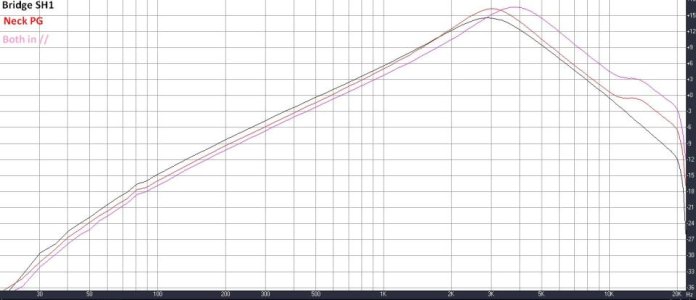Inflames626
New member
Hi all,
So a common way I wire my passive guitars up these days is independent volume knobs for each humbucker and a tone knob. I also tend to put a push/pull phase switch on the neck pickup and a Shadow volume/killpot on the bridge.
I do independent volume knobs because I *think* my ears can hear a difference when I go to the middle toggle position and turn one pickup down. Usually I go to middle toggle and turn down the bridge pickup to get a slightly cleaner neck pickup tone. This seems to be a "less than series but not parallel coil" sound.
I know this is not the same as playing through a pickup with its coils in parallel. Here, the pickups themselves are in parallel but the coils are in series.
So, if you go to the middle toggle position, does this thin out the tone of the pickups somewhat through the toggle switch, or am I imagining it?
It doesn't seem to same as playing both pickups at the same time in their respective toggle positions or through each other in a megabucker wiring scheme. It's like playing both pickups through the middle toggle sums them both, but also reduces their output a bit so the middle position doesn't become twice as loud as the neck or bridge pickup playing alone.
For my cleanest sound, usually with a neck pickup, I will go to the middle toggle position, turn down the bridge pickup to isolate the neck, put the neck pickup in parallel with a Triple Shot, and use an out-of-phase tone all at the same time.
If using the middle toggle position does thin the pickups tone a bit, this gives me another tone to use that is less than series but not fully parallel, especially when I isolate one pickup by turning the other down.
I'm aware that independent volume knobs will change the treble response as the knob is turned down and that Strat guys have all these treble mod modifications for it.
Hope this makes sense.
Thanks.
So a common way I wire my passive guitars up these days is independent volume knobs for each humbucker and a tone knob. I also tend to put a push/pull phase switch on the neck pickup and a Shadow volume/killpot on the bridge.
I do independent volume knobs because I *think* my ears can hear a difference when I go to the middle toggle position and turn one pickup down. Usually I go to middle toggle and turn down the bridge pickup to get a slightly cleaner neck pickup tone. This seems to be a "less than series but not parallel coil" sound.
I know this is not the same as playing through a pickup with its coils in parallel. Here, the pickups themselves are in parallel but the coils are in series.
So, if you go to the middle toggle position, does this thin out the tone of the pickups somewhat through the toggle switch, or am I imagining it?
It doesn't seem to same as playing both pickups at the same time in their respective toggle positions or through each other in a megabucker wiring scheme. It's like playing both pickups through the middle toggle sums them both, but also reduces their output a bit so the middle position doesn't become twice as loud as the neck or bridge pickup playing alone.
For my cleanest sound, usually with a neck pickup, I will go to the middle toggle position, turn down the bridge pickup to isolate the neck, put the neck pickup in parallel with a Triple Shot, and use an out-of-phase tone all at the same time.
If using the middle toggle position does thin the pickups tone a bit, this gives me another tone to use that is less than series but not fully parallel, especially when I isolate one pickup by turning the other down.
I'm aware that independent volume knobs will change the treble response as the knob is turned down and that Strat guys have all these treble mod modifications for it.
Hope this makes sense.
Thanks.

